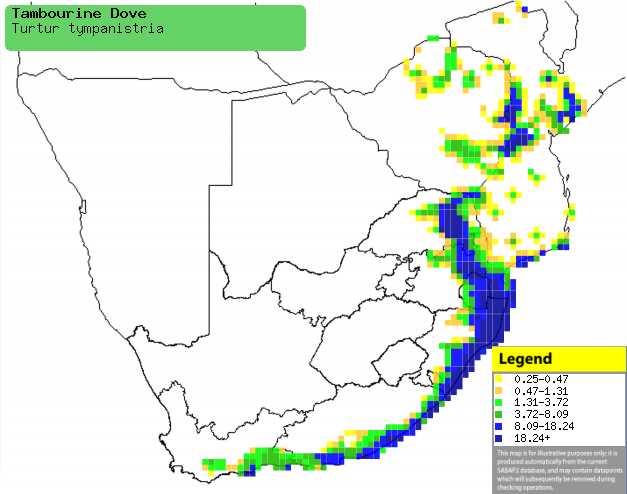|
Turtur tympanistria (Tambourine
dove)
Witborsduifie [Afrikaans]; Isavu [Xhosa]; isiBhelu,
isiKhombazane-sehlathi [Zulu]; Xivhambalana (generic term for dove) [Tsonga];
Tamboerijnduif [Dutch]; Tourtelette tambourette [French]; Tamburintaube
[German]; Rola-de-papo-branco [Portuguese]
Life
> Eukaryotes >
Opisthokonta
> Metazoa (animals) >
Bilateria >
Deuterostomia > Chordata >
Craniata > Vertebrata (vertebrates) > Gnathostomata (jawed
vertebrates) > Teleostomi (teleost fish) > Osteichthyes (bony fish) > Class:
Sarcopterygii (lobe-finned
fish) > Stegocephalia (terrestrial
vertebrates) > Tetrapoda
(four-legged vertebrates) > Reptiliomorpha > Amniota >
Reptilia (reptiles) >
Romeriida > Diapsida > Archosauromorpha > Archosauria >
Dinosauria
(dinosaurs) > Saurischia > Theropoda (bipedal predatory dinosaurs) >
Coelurosauria > Maniraptora > Aves (birds) >
Order: Columbiformes > Family: Columbidae > Genus:
Turtur
The Tambourine dove occurs across sub-Saharan Africa, from
Senegal to Uganda south to southern Africa. Here it is locally common in
riverine woodland and evergreen forest, often occupying coastal forest in the
Western and Eastern Capes. It eats a variety of fruit, seeds and invertebrates,
usually foraging on the ground. Both sexes construct the nest, which is a
fragile saucer made of twigs, leaves and petioles, placed in tangled creepers,
bushes or trees. Here it lays 1-2 eggs, which are incubated mainly by the female
for about 17-20 days .The chicks are fed about four times daily by both parents,
who regurgitate food eaten previously. They are brooded constantly for the first
few days of their lives, staying in the nest for about 19-22 days.
Distribution and habitat
Occurs across sub-Saharan Africa, excluding arid areas. Here it is locally common in
Zimbabwe, Mozambique, Swaziland, the Limpopo province and large areas of the
east coast of South Africa, from KwaZulu-Natal to the Western Cape. It generally
prefers riverine woodland and evergreen forest, often occupying coastal forest
in the Western and Eastern Cape.
|
 |
|
Distribution of Tambourine dove in southern Africa,
based on statistical smoothing of the records from first SA Bird Atlas
Project (©
Animal Demography unit, University of
Cape Town; smoothing by Birgit Erni and Francesca Little). Colours range
from dark blue (most common) through to yellow (least common).
See here for the latest distribution
from the SABAP2. |
Food
It eats a variety of fruit, seeds and
invertebrates, usually foraging on the ground. The following food items have
been recorded in its diet:
- Plants
- seeds
- grasses
- trees
- Albizia
- Celtis
- Croton
- Ricinus communis (alien Castor Oil Bush)
- small fruit
- Solanum
- Syzygium cordatum (Waterberry)
- Trema orientalis
- Invertebrates
Breeding
- Both sexes construct the nest, which is a fragile saucer made of twigs,
leaves and petioles. The male collects material and hands it to the female,
who then incorporates it to the structure. It is typically placed among the tangled
branches of a creeper, in a bush or tree, often in vegetation next to
rivers.
- Egg-laying season is from about September-May.
- It lays 1-2 eggs, which are incubated mainly by the female for about
17-20 days.
- The chicks are fed about four times daily by both parents, who
regurgitate food eaten previously. They are brooded constantly for the first
few days of their lives, staying in the nest for about 19-22 days.
Threats
Not threatened.
References
-
Hockey PAR, Dean WRJ and Ryan PG 2005. Roberts
- Birds of southern Africa, VIIth ed. The Trustees of the John Voelcker
Bird Book Fund, Cape Town.
|
